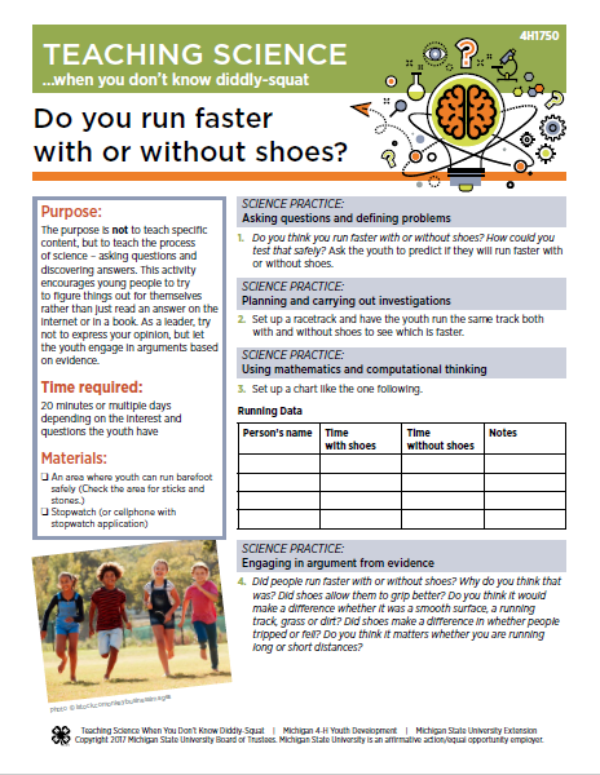
Bulletin 4H1750
Teaching science when you don't know diddly squat: Do you run faster with or without shoes?
DOWNLOAD
October 9, 2018 - Michigan State University Extension
Purpose
The purpose is not to teach specific content, but to teach the process of science – asking questions and discovering answers. This activity encourages young people to try to figure things out for themselves rather than just read an answer on the internet or in a book. As a leader, try not to express your opinion, but let the youth engage in arguments based on evidence.
Time required
20 minutes or multiple days depending on the interest and questions the youth have.
Materials
- An area where youth can run barefoot safely (Check the area for sticks and stones.)
- Stopwatch (or cellphone with stopwatch application)
Science practice:
Asking questions and defining problems
1. Do you think you run faster with or without shoes? How could you test that safely? Ask the youth to predict if they will run faster with or without shoes.
Science practice:
Planning and carrying out investigations
2. Set up a racetrack and have the youth run the same track both with and without shoes to see which is faster.
Science practice:
Using mathematics and computational thinking
3. Set up a chart like the one following:
Running Data
|
Person’s name |
Time with shoes |
Time without shoes |
Notes |
|
|
|
|
|
|
|
|
|
|
|
|
|
|
|
|
|
|
|
|
Science practice:
Engaging in argument from evidence
4. Did people run faster with or without shoes? Why do you think that was? Did shoes allow them to grip better? Do you think it would make a difference whether it was a smooth surface, a running track, grass or dirt? Did shoes make a difference in whether people tripped or fell? Do you think it matters whether you are running long or short distances?
Science practice:
Constructing explanations and designing solutions
5. Based on what you observed, is there anything you could use when making shoes? Do you have any new ideas for making shoes? What type of materials would you use? What style would you choose? What type of tread design would you use?
Other thoughts:
- Do you think certain shoes would allow you to run faster? Would some types of shoes slow you down?
- Does what you learned in this experiment make arguments for or against toe shoes (shoes with individual toe pockets) or other types of minimalist shoes?
Science and Engineering Practices
These eight Science and Engineering Practices come from A Framework for K–12 Science Education (National Research Council, 2012, p. 42). These research-based best practices for engaging youth in science are connected to in-school science standards that all children must meet.
- Asking questions and defining problems
- Developing and using models
- Planning and carrying out investigations
- Analyzing and interpreting data
- Using mathematics and computational thinking
- Constructing explanations and designing solutions
- Engaging in argument from evidence
- Obtaining, evaluating, and communicating information
Reference
National Research Council. (2012). A framework for K-12 science education: Practices, crosscutting concepts, and core ideas. Washington, DC: National Academies Press.



 Print
Print Email
Email




